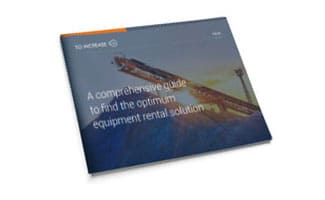Which Option Is Better? Cloud-Based Equipment Rental Software versus Local Rental Software
 Michiel Toppers
Michiel Toppers
Table of contents
The equipment rental industry has come into its own in recent times with the increased demand for asset rentals as opposed to outright purchases.
While this has had a positive impact on the demand side of the business, equipment rental companies face challenges like the demand for better rates, customized services, a more diversified portfolio, operational issues, etc., due to the increasing competition in the market.
One of the ways that an equipment rental company can maintain its competitive advantage is by ensuring it has the means to take care of continually changing customer demands without compromising on its profitability. At STAEDEAN, we offer STAEDEAN Rental Management—a full-featured, cloud-based equipment rental software solution that can help you do that.
The question that customers often ask us at STAEDEAN is what their options are when it comes to managing their rental operations. When it comes to running your equipment rental business, there are several options open to you, including best-of-breed solutions, an integrated software package, customized work solution, local rental software, and a cloud-based software solution.
Here is a comparison between a cloud-based equipment rental software solution and local rental software solution on various factors. These factors include the cost, customization, support, information access, ERP integration, coding support, operations support, IoT and BI.

- Cost
Cloud-Based Equipment Rental Software
For this option, cost is a factor that depends on the number of users — the cost increases with the number of users and the complexity of your operations. When you consider these factors, it can seem like a hefty investment from your end. The cost of a cloud-based equipment rental software can range from €45 to €65 per user per month depending on your solution option.
Local Equipment Rental Software
When you are developing local software, companies conclude that the costs would be in control as the solution is being developed in-house. However, the hidden costs keep mounting when you consider the addition of IT staff you have to make to develop and maintain the product.

The winner
Though it is difficult to determine a clear winner, the cloud-based equipment rental software has many benefits to offer. The local software can only be cost-effective if you have more users to ensure economies of scale, with costs going up by as much as 60%.
- Customization
Cloud-Based Equipment Rental Software
The solution provider’s expertise and experience in the industry can keep the need for customizations at a minimum. What is more, it is also possible that solution provider has enabled the product to require configuration rather than coding, which makes customizations easier.
Configuration can be done by the users themselves rather than depending on the IT team for coding support. What is more, configuration also ensures that the product is user-friendly.
Local Equipment Rental Software
When you have local rental software, your own IT department can undertake customizations. The response would be quicker, and the changes can be implemented with immediate effect. However, the downside is that the changes that the IT department makes may be from a technical point of view rather than the operational side of the business.
The winner
The winner in this case would be the local equipment rental software because of the turnaround time and immediate action.
- Support
Cloud-Based Equipment Rental Software
The software solution provider in most instances would have various means to provide the users with support. These could include in-person training, virtual tutorials, FAQs, bug fixes, etc. What is more, the solution provider can draw on their experience of working with customers to ensure that instances that require support are minimized.
Local Equipment Rental Software
In this case, your in-house IT team can provide you immediate support but unless their core expertise is in the equipment rental industry, this may not be that effective. Lot of time and effort would be lost in understanding the problem and how to mitigate it.
The winner
In this case, the winner would be the cloud-based equipment rental software as they would be able to minimize instances where support is required.
- Information access
Cloud-Based Equipment Rental Software
The cloud-based equipment rental software has a definite edge here because of the cloud factor. Features like mobility, role-based access, shared planboards, etc., can make information access not only easy but also secure.
Local Equipment Rental Software
In this instance too, the access to information can be quick and easy. However, as the solution may not be cloud-based, the mobility factor would be restricted, limiting the scope of access.
The winner
Cloud-based equipment rental software is the clear winner for this feature.
- ERP integration
Cloud-Based Equipment Rental Software
The basis of cloud-based equipment rental software is often with a particular ERP making the process automatic and easy. The in-built sync features would ensure that the operational aspects and the financial aspects of the equipment rental business are in sync, ensuring that information is not siloed and out of date.
Local Equipment Rental Software
The sync with ERP is a separate consideration that the IT team in your company must work on and would require considerable time and effort to configure. This can bring a divide in the information available to the operational team and the financial team.
The winner
Cloud-based equipment rental software leads in this aspect.
- Coding support
Cloud-Based Equipment Rental Software
While coding support may not be forthcoming with this option, it is vital to consider that it may not be needed at all. With cloud-based equipment rental software solutions, the solution provider knows the needs of its customers. Keeping this in mind, they ensure that their products do not need coding support and that changes can be made with configuration.
Local Equipment Rental Software
With local equipment rental software, coding support would be immediate and responsive to the needs of the users. However, the downside is that the operational team would be entirely dependent on the coding team every time they required any changes to the product.
The winner
Though the local equipment rental software is the clear winner in this aspect, the cloud-based equipment rental software offers more cost savings and operational advantages.
- IoT and BI
Cloud-Based Equipment Rental Software
In the IoT and BI aspects, the cloud-based equipment rental software leads as the solution provider has access to industry best practices, deep domain expertise, and years of focused experience. All these factors translate to the correct leveraging of IoT to improve revenue, minimize costs and plan transportation better. The solution provider is also better placed to offer business intelligence that is specific to the rental industry.
Local Equipment Rental Software
While the local equipment rental software can add IoT to their solution, there could be cost implications in absolute terms and additional factors like increasing the team size, buying technology, etc. Any business intelligence they offer would be inward-focused, making its impact weaker.
The winner
Cloud-based equipment rental software is the clear winner here.
- Operations support
Cloud-Based Equipment Rental Software
The cloud-based equipment rental software offers a complete overview of the equipment portfolio, the lifecycle of each equipment, the service and maintenance requirements, transportation requirements, the operator needed, etc., in a consolidated manner. These factors, along with features like the graphical planboard, help in better planning and to improve operations.
Local Equipment Rental Software
In many instances, the local IT team would be able to provide operations support since they are locally based and will be able to attend any queries the operations team has at once. However, they can, in most instances, lack the depth and understanding that a cloud-based equipment rental solution would be able to bring.
The winner
In this case, it is a draw with both sides having their own pros and cons.
Here’s what comes next
Now that you have gone through the complete comparison between a cloud-based equipment rental software solution and a local equipment rental solution, you need to list out the requirements of your company to decide which one is right for you.
You can start by asking the following questions:
- What are our expectations from an equipment rental solution?
- What is our budget?
- What are our future plans for expansion—geographically, domain-wise?
- Do we want to expand our IT department?
- Does our IT team have the expertise to build an equipment rental solution?
This can be the starting point towards selecting the right equipment rental software solution that will meet your requirements.


